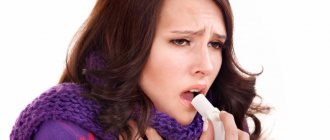A mentally healthy person never intentionally injures himself or herself, but in the event of various deviations from the norm, the patient may experience an obsessive and irresistible desire to self-harm his skin. These actions can be spontaneous or unconscious and are always associated with certain mental abnormalities. A person may cut their skin, scratch it, bite their cheeks or lips, pull out hair, or bite their nails and the skin around them. Doctors use the term “pathomimia” to refer to this pathology. Translated from Greek, this word means the concept of “depiction of suffering and pain.”
The modern rhythm of life often leads to the development of mental disorders and depressive states, and that is why the number of patients with pathomymia is steadily increasing. According to statistics, this pathology is observed in 0.8% of people, and most of them are women. Most often, pathomimia begins to develop in adolescence.
In this article we will introduce you to the causes, varieties, symptoms, methods of diagnosis and treatment of this complex illness associated with mental disorders. This information will help you timely notice the alarming symptoms of pathomimia in yourself or your loved ones and take appropriate measures to get rid of this self-destructive disease.
Causes
Patomimia (or artificial dermatitis, artificial dermatitis) is a disease that requires the intervention of not only dermatologists, but also psychotherapists and neurologists, since skin lesions are inflicted by patients independently in order to imitate the disease. Such actions are caused by auto-aggression, which is always a consequence of mental disorders, alcoholism, behavioral disorders or severe depressive conditions. That is why self-harm is studied in such a branch of medicine as psychodermatology.
Pathomimia is always associated with auto-aggressive actions provoked by various mental disorders. The diversity of such pathologies requires a differential approach to therapy.
Usually pathomimia is caused by neurotic conditions, psychoses or psychopathy. With such pathologies, patients treat themselves uncritically and do not independently seek help from a psychotherapist, but come to see a dermatologist. An experienced doctor may suspect the true nature of the disease and refer the patient to the appropriate specialist. Sometimes pathomimia is provoked by endocrinological and genetic abnormalities or occupational diseases.
Self-harm during pathomymia can be caused by:
- consciously and demonstratively (in borderline states);
- unconsciously (with obvious mental pathologies or behavioral disorders);
- for the purpose of obtaining benefit (i.e. simulation).
In most cases, self-harm is caused to patients unconsciously and is caused by mental disorders. Patomimia can be observed in the following mental conditions and disorders:
- histrionic personality disorder;
- organic brain damage;
- obsessive-compulsive disorder;
- dissociative disorders;
- post-traumatic syndrome;
- mental retardation;
- oligophrenia;
- schizophrenia;
- anhedonia;
- autism.
Auto-aggression is shown by people who want to avoid emotional stress or conflict. This action towards themselves in a unique way replaces fears, feelings of inferiority or anxiety. According to research, self-mutilation in pathomimia is first inflicted in response to traumatic events, and then the desire to injure oneself can arise as a result of any, even the most minimal, psychological experience. The patient begins to secretly (and sometimes demonstratively) injure himself and, as a rule, chooses the same traumatic method (scratching, cutting, nail biting, etc.). Before causing injury, he panics and worries, but after performing the action he feels a sense of satisfaction and calm.
Pathomimia is not always a consequence of mental pathologies. Auto-aggression, causing self-harm, can develop when:
- alcoholism and drug addiction;
- depressive disorders;
- emotional lability;
- infantilism.
Causes of pathomymia
Self-harmful behavior is always based on auto-aggression - a mentally normal person will not intentionally harm himself.
That is, the main cause of pathomimia is mental disorders caused by psychogenic factors. At the same time, the actions of a person with such behavior have two vectors of direction: he strives to injure the skin (mucous membranes) and initiate dermatological diseases. Given this nature of self-harmful behavior, the most fertile ground for its development is created by:
- Mental disorders
. Most often, hysteria, depression, schizophrenia, various phobias and manias, dissociative, obsessive-compulsive disorders, autism, psychoses and neurotic conditions can lead to pathomimia. - Dependencies
. No less dangerous in terms of the emergence of desires to harm oneself are addictions to bad habits - alcoholism, drug addiction. - Post-traumatic syndrome
. Self-harmful behavior can be a response to one or repeated traumatic situations: violence, including sexual violence, participation in hostilities, severe physical trauma, etc. - Organic brain lesions
. An uncontrollable desire to injure oneself may appear in the presence of Alzheimer's disease, atherosclerosis, intoxication with alcohol, heavy metals, and the consequences of chronic renal and/or heart failure. - Problems with intellectual development
. The tendency to engage in self-traumatization can be observed in people with mental retardation and imbecility. - Behavioral disorders
. The effect on the body, including the brain, of taking psychoactive substances and physiological disorders can also make a person want to injure himself. This also includes disorders of desire and sexual preference. - Personality features
. Infantility, increased sensitivity, anxiety, aggressiveness, and emotional instability can push a person to such an extraordinary manifestation of internal experiences.
There is evidence that diseases that do not relate to the mental sphere - somatic (endocrine, occupational pathologies), as well as genetic abnormalities - can provoke the desire to self-mutilate.
Types of autoaggression in pathomimia
Self-harm that was provoked by pathomymia is divided into the following types:
- dermatomania - an uncontrollable desire to damage the skin, its appendages and mucous membranes;
- onychophagia - an uncontrollable desire to damage the nails;
- dermatolasia – an uncontrollable tendency to damage the skin around the nail bed;
- cheilophagia - an uncontrollable desire to damage the integrity of the lips (or the inner surface of the cheeks);
- trichotillomania is an uncontrollable urge to pull out hair.
One of the most common forms of dermatomania is neurotic excoriation. In this condition, the patient repeatedly scratches his skin, and extremely varied forms of damage can be observed on the body: from small abrasions with reddened edges to deep wounds with bloody crusts and scars.
Types of pathomimia
Depending on the part of the body on which the impact is applied, they are divided into:
- dermatomania (effects on the skin);
- trichotillomania (hair damage);
- cheilophagia (damage to the lips and tongue through bites);
- onychophagia (a person bites nail growths on his fingers);
- dermatozoan delirium (the desire to get imaginary parasites from under the skin);
- excoriated acne (impact on inflammation caused by acne and other acne diseases);
- dermatolasia (rubbing or pressing on the skin to cause irritation).
In addition, there is conscious and unconscious auto-aggression for the sake of profit. Often, patients with unconscious pathomimia are not able to diagnose their diseases; do harm to the body unconsciously out of habit or some other reason. For such patients, treatment is easier, because the main task will be to explain to the patient about the disease and its negative consequences.
Symptoms
The main symptoms of pathomymia include the following:
- systematic appearance of new damage;
- causeless occurrence of damage;
- the presence of damage only in areas of the body that are easily accessible to the patient;
- failure of dermatological treatment;
- uniformity of damage;
- regular or linear location of damage;
- patient complaints of itching or pain in areas of injury;
- a negative attitude towards the assumption of the presence of a mental disorder that provoked self-harm or attempts to categorically and unmotivatedly refuse to consult a psychotherapist.
The clinical picture of pathomimia is very diverse. On the body of patients, ordinary scratches or cuts, burns, deep necrotic skin lesions and ulcers, subcutaneous hemorrhages and multi-bubble rashes can be observed. Sometimes the lesions resemble various dermatological diseases and rare dermatoses.
With dermatomania, patients can spend a long time preoccupied with their appearance: opening blisters of rashes with their nails, squeezing out non-existent acne for hours, etc. On areas of the body accessible to the patient’s hands, abrasions with reddened edges, deep wounds with bloody crusts and scars from long-standing injuries are found.
The following skin defects are most often found on the body of such patients:
- abrasions;
- ulcers;
- hematomas;
- scratching;
- erosion from burns;
- excoriated acne;
- bullous rashes;
- dermatitis.
If there is a tendency to pull out hair on the head or other parts of the body, areas of torn hair are identified. Sometimes redness, superficial abrasions, atrophic changes and scars are found in such areas. The patient may complain of intense itching in the area of such damage.
With onychophagia and dermatolasia, the patient has severely bitten nails and areas of skin damage around the nail bed. Skin damaged in these areas can become inflamed and scarred. Over time, it becomes rougher, and the hands acquire an extremely unaesthetic appearance.
With cheilophagia, wounds and abrasions are found in the lips or on the mucous membrane of the cheeks, which are provoked by constant biting. The patient may complain of discomfort while eating, but these unpleasant sensations do not stop him from causing further damage.
In some cases, pathomimia is accompanied by systematized dermatozoal delirium. Patients with such a deviation demonstrate to the doctor and those around them the most “affected” areas of the body and can suggest that the specialist “urgently conduct an examination” of various skin flakes, crusts, hair or areas of the nail plates, which they put in advance in jars or boxes. Such patients may constantly wash their body, scrape it, and examine it under a magnifying glass. They can destroy “parasites” that supposedly live in the hair, on the skin or under the nails, using cutting objects, acids, etc. Panic fear of germs forces them to disinfect or boil their underwear and get rid of “contaminated” clothes. Such patients may be afraid of infecting their family or friends. In some cases, this condition can lead to suicide attempts.
Manifestations of pathomymia in humans
Self-harmful behavior is characterized by a systematic and conservative method of traumatization.
That is, the patient mutilates himself regularly and in the same way. Moreover, he can do this secretly, unconsciously, which is most often found in mental and behavioral disorders. But there are cases when a person suffering from pathomimia injures himself, fully understanding his behavior, even demonstratively (in borderline states). There are also incidents where people engage in self-mutilation in order to feign illness. The main symptoms of pathomymia can be divided into several groups:
- According to the nature of the damage
. Such skin lesions have no apparent cause and in most cases are of the same type. - According to the location of the damage
. Pathomimic injuries are localized exclusively in places accessible to the patient himself and, since they are inflicted intentionally, are placed in the correct order, linearly. - For the treatment of injuries
. Dermatological methods of treating injuries do not produce results, since the patient again and again inflicts new injuries on himself. Thus they fall into the category of “chronic” or “untreatable”. - According to the patient's behavior
. Often a person who suffers from pathomimia complains of itching and pain in the places of self-torture. At the same time, he denies any attempts to connect his condition with mental problems, much less seek help from a psychiatric specialist.
The visible results of such self-destructive tactics of behavior can be the following damage to the patient’s body:
- Superficial skin damage
. The most common signs of self-injury are scratches, scratches, and abrasions. Often, traces of teeth bites, cuts, and punctures can be found on the skin of patients. - Damage to the skin by fire, aggressive substances
. Following their uncontrollable desires or beliefs, “self-torturers” can leave burns on their skin (from open fire, cigarettes, iron, etc.), which, due to lack of treatment or continued traumatization, can turn into erosion. - Consequences of skin damage
. Often, a specialist who examines the skin of a patient with pathomymia can see not only fresh traces of self-harmful behavior, but also its consequences - ulcers, necrotic changes, blistering rashes, deep wounds, scars, dermatitis, subcutaneous hemorrhages. - Damage to hair
. If a patient suffers from a mania for damaging his hair, then areas of torn hairs with redness, abrasions, scars, and atrophy can be found on his body.
At the same time, patients can carefully monitor their appearance - squeeze out non-existent blackheads and pimples, open blisters, etc.
If a person has developed dermatozoal delirium, he can persistently demonstrate to others and doctors his terrible skin “disease”, scrupulously collect its evidence (hairs, scales and crusts, pieces of nail plates) in boxes and jars and insist that they be examined. This self-harming behavior forces them to devote a lot of time to hygiene and self-care: they wash themselves frequently and thoroughly, constantly wash and boil linen and clothes. They spend a long time looking at their “problem” on the skin under a magnifying glass, trying to get rid of it. For example, if they are sure that some kind of parasites live in the skin, they can use their nails, piercing and cutting objects, and acids in order to get them out.
Some people suffering from self-harm disorder imitate dermatological pathologies so “professionally” that even an experienced specialist may find it difficult to immediately recognize the “trick.” The most common diseases that patients with pathomymia “exploit” are hemorrhagic vasculitis and seborrheic pemphigus.
Diagnostics
Identifying pathomymia can be quite a difficult task, since patients almost always hide or are not aware of the true origin of the damage and refuse to consult a psychiatrist. There are cases where patients managed to hide the fact of self-harm for many years.
A doctor may suspect the presence of pathomimia based on an implausible story about the appearance of areas of damage to the skin or its appendages, atypical skin changes, and strangeness or eccentricity in the patient’s behavior.
To establish a diagnosis of “pathomimia”, it is necessary to carry out the following measures:
- histological examination;
- psychological conversation with the patient or consultation with a psychotherapist;
- Ultrasound skin scanning.
Performing a histological examination or ultrasound scan allows the doctor to determine the cause of skin lesions and exclude possible dermatological pathologies. A psychological conversation or consultation with a psychotherapist in the absence of “real” causes of damage to the skin, its appendages or mucous membranes allows us to identify psychological or mental abnormalities in the patient. When identifying such disorders, the doctor can draw up tactics for further treatment of the patient, taking an individual approach to the treatment of the main cause of the disease (i.e., auto-aggression).
Establishing diagnosis
Despite the lack of a clear clinical picture, diagnosing pathomimia is quite simple. An experienced dermatologist can evaluate the nature of the damage and determine its origin. In the vast majority of cases, patients refuse to consult a psychiatrist. Help will be provided by a psychodermatologist, neurologist, and endocrinologist. Often a consultation with a trichologist and cosmetologist is required.
The patient may be prescribed the following medical procedures:
- ultrasound examination of the skin;
- histological study of biomaterial;
- psychological consultation.
The greatest benefit will come from communicating with a psychologist. Patients are wrong to believe that a doctor of this specialization works exclusively with mentally ill people. A psychiatrist is able to delve into the depths of the problem and find the true causes of auto-aggression.
Treatment
Psychotherapy occupies a special place in the treatment of pathomimia.
Treatment of patients with pathomimia is often associated with many difficulties, since patients react negatively to the need to see a psychiatrist and undergo psychotherapeutic therapy. Some patients, after “exposing” the cause of skin changes, may refuse treatment and no longer come for appointments.
Treatment of pathomymia should always be comprehensive and include the following main areas:
- psychotherapeutic activities;
- drug therapy;
- physiotherapy.
If a patient has severe mental disorders that are accompanied by insurmountable obsessive or delusional states, hospitalization in a neuropsychiatric hospital is indicated. This approach helps to avoid subsequent self-harm and control the situation.
In the absence of severe mental disorders, there is no need for hospitalization. The doctor can find out the causes of auto-aggression and explain to the patient how to get rid of it. To stabilize psychological and mental balance, the patient is prescribed cognitive behavioral psychotherapy. If the patient does not remember how he self-harmed, then the use of psychoanalytic techniques may be necessary. If necessary, the treatment plan includes sedatives, antidepressants, antipsychotics and psychotropic drugs.
To treat skin damage, various topical preparations are used that have anti-inflammatory, wound-healing, restorative and anti-scarring effects. If it is necessary to eliminate significant skin defects, the patient may be prescribed treatment by a cosmetologist.
To eliminate psychogenic dermatitis, the patient is prescribed various physical procedures:
- laser therapy;
- paraffin therapy;
- electrophoresis;
- ultrasound treatment;
- ultraviolet treatment.
Such procedures allow you to speed up the process of getting rid of skin lesions and have a beneficial effect on the general condition of the patient.
The main part of the treatment for pathomymia should be carried out by a psychotherapist, and a dermatologist or cosmetologist can help the patient get rid of skin defects.
In most cases, with an integrated approach to therapy, the prognosis of this disease is favorable, and the patient can completely get rid of auto-aggression and addiction to self-harm.
Patients with schizophrenia accompanied by dermatozoal delirium are the most difficult to treat. It is possible to achieve stabilization of their condition only in a psychoneurological hospital. As a rule, the condition of such patients can improve six months after complex therapy.
Unconventional methods of treatment
Therapy with alternative medicine does not produce tangible results. But such treatment can speed up recovery and alleviate the patient’s condition. Mental disorders are contraindications for acupuncture, but in this case this treatment method may be beneficial. Firstly, acupuncture has a beneficial effect on a person’s general condition. Secondly, skin punctures for medicinal purposes will remove the psychological dependence on self-harm and will reinforce the medical nature of such actions in the patient’s subconscious.
Passion for folk recipes can result in aggravation of the disease. However, herbal remedies with a calming effect are not excluded. In consultation with a doctor, it is permissible to use chamomile, mint, lemon balm, and motherwort.
The use of homemade medicines should not cancel classical therapy.
For external treatment, herbal decoctions with anti-inflammatory and healing effects are recommended. Infusions with oak bark, calendula, and chamomile have a positive effect on the condition of the skin. Agave has proven itself well. The juice from the leaves of the plant increases local immunity and enhances tissue trophism. You can use fresh juice or alcohol tincture for pustular skin lesions, cuts, burns, and ulcers.
Aromatherapy gives good results. Essential oils of lavender, jasmine, and chamomile have a calming effect. Color therapy and meditative music enhance the effectiveness of conservative treatment and have a positive effect on the nervous system.
Diagnosis of pathomymia
Identifying this disorder is not an easy task. There are cases where it took specialists more than one year to recognize the disease.
The following are considered diagnostic confirmations of pathomymia:
• bizarre outlines of rashes of various sizes or polygonal nature of scratches;
• disfiguring self-harm of a grotesque nature in the schizophrenic process;
• unchanged dermis around wounds;
• frequent occurrence of new injuries of the same type
• localization of lesions in places most accessible to the patient: on the forearms, thighs, face, upper back;
• itching or pain in the injured areas;
• with a pronounced nature of auto-aggression, patients persistently deny the fact of involvement in it;
• during a psychiatric examination, psychopathic personality traits are often revealed, prone to aggravation, hysteria, and obsessive thoughts;
• with delusional disorders, in particular manic-depressive psychosis, patients experience tactile hallucinations, it seems to them that some insects are crawling on them, so they constantly disinfect their body and underwear;
• patients can show the doctor containers with particles of skin or its appendages that they have scraped off, requesting analysis of this material;
• detection of self-harm instruments in the patient, after removal of which the pathological symptoms quickly disappear.
The following methods help to establish a reliable diagnosis:
• psychoanalytic conversation aimed at identifying the true causes of damage and the patient’s awareness of his involvement in artificial dermatosis;
Be healthy!
Patomimia is artificial damage to the skin, hair and nails, inflicted by the patient on himself in order to reduce emotional stress, aggravate dermatological symptoms or due to a mental disorder. Objective signs are burns, ulcerative-necrotic lesions localized on areas of the skin accessible to the patient. Diagnosis is based on a clinical conversation, examination of the skin, and histological examination. Treatment includes psychotherapy, psychopharmacotherapy, and the use of local medications.
General information
Patomimia is a psychogenic dermatosis. The term comes from the ancient Greek language, “pathos” means suffering, illness, and “mimos” means imitation, image. Self-harm during pathomimia is caused by patients with intent - to convince others of the presence of a skin disease, or can be formed as compulsive uncontrollable actions that reduce mental stress. According to statistics, symptoms of pathomimia of varying severity are diagnosed in 5-30% of people. The peak incidence occurs in childhood and adolescence.
Causes
A number of personal qualities predispose to self-harming behavior: infantility, emotionality, sensitivity. Patomimia is more often diagnosed in people who have a hard time with life’s failures and have a high degree of anxiety combined with a tendency to aggression. The risk of the disease increases with alcoholism and drug addiction. Common causes of pathomymia include:
- Psychogenic disorders. Patomimia is possible with post-traumatic stress disorder, depression, and obsessive-compulsive disorder. Damage to the skin, nails and hair allows you to relieve tension and switch attention from the problematic situation to sensations in the body.
- Personality disorders. With psychopathy, character traits are sharpened and difficult to control. Self-harm is often caused by people with severe anxiety, impulsiveness, and intrapunitiveness (the tendency to blame oneself for all failures).
- Hysteria. In this disorder, self-harm is associated with emotional tension, as well as with a subconscious desire to attract the attention of others - to receive secondary benefit in the form of care, treatment, and the creation of special conditions.
- Schizophrenia. Patients are prone to various forms of auto-aggressive behavior and can inflict disfiguring self-harm. Artificial dermatoses are often caused by the content of delusions and hallucinations, for example, cuts and scratches are an attempt to expel insects from under the skin.
- Organic diseases of the central nervous system. Patomimia develops as a symptom of neuroinfection, brain tumor, consequences of traumatic brain injury or stroke. The self-aggressive behavior of patients often takes rough forms and can only be corrected with medication.
Pathogenesis
Damaging actions are the result of a redirection of hostility that is initially focused on an external object (real or imaginary). Patients with pathomymia use auto-aggression as a means to avoid or eliminate emotional tension and internal conflicts. Self-harm replaces anxiety and fears and serves as a way of coping with the symptoms of another disease.
In the pathogenesis of pathomimia, psychoanalysts identify frustration, a traumatic situation, and negative feedback. The inability to satisfy an urgent need provokes an internal conflict that inhibits aggression. A psychotraumatic event, stress or illness exacerbates intrapersonal confrontation, aggression is expressed towards oneself. Sometimes the experience of pain is necessary to compensate for emotional inertia and to attract attention.
Classification
Pathomymia combines several variants of disorders. Self-harm affects not only the surface of the skin, but also nails, hair, and areas of glandular ducts. Based on the origin and nature of the symptoms, pathomimic disorder is divided into several types, of which the most common are:
- Trichotillomania. It manifests itself as independent hair removal on the head, face and other parts of the body. Patients pull out and twist their hair.
- Onychotillomania. This term refers to self-harm of the nail plates as a result of compulsive actions. Patients use their own hands, forceps, nail scissors, and files.
- Onychophagia. With onychophagia, patients bite their nails with their teeth. Children of preschool and primary school age are more susceptible to the disorder.
- Cheilophagy. It manifests itself as obsessive licking and biting of the red border of the lips. Atopic cheilitis may be a provoking factor.
- Excoriated acne. This is self-harm of the skin against the background of inflammatory diseases of the hair follicles and ducts of the sebaceous glands. Patients aggravate the course of acne, folliculitis, and keratosis pilaris.
- Dermatolasia. The basis is an obsessive state, which is accompanied by a desire to provoke skin irritation. Patients pinch, knead, rub healthy skin, potentiating focal lesions.
- Dermatozoan delirium. The disorder is characterized by the presence of a delusional idea about a skin disease. Patients examine their skin in detail, destroy “living creatures” and “germs” by scraping, frequent washing, and acid treatment.
Symptoms
The clinical picture of the pathology is varied and is represented by burns, ulcerative formations, and necrotic lesions. Patients exhibit multi-bubble rashes, subcutaneous hemorrhages and other pathological changes in the skin, nail plates and hair. Sometimes the symptoms mimic dermatoses, but characteristic signs of pathomymia can always be identified.
The lesions are uniform and have sharp boundaries with unchanged healthy skin around them. Secondary elements predominate - erosion, scabs, ulcers, pigmentation. The damage has a correctly linear arrangement, localized in those parts of the body that are accessible to the patient: on the face, neck, head, chest, limbs. The back, buttocks, and back of the thighs usually remain intact.
Dermatological treatment is ineffective, despite properly selected medications, because the basis of regular repeated skin damage is an emotional-behavioral disorder. Most often, patients react negatively to the assumption of a doctor or other medical personnel about the psychogenic nature of symptoms. Self-harm is done in privacy, always in one familiar way.
Complications
Without adequate dermatological treatment, pathomimia is complicated by secondary skin infections with the formation of purulent foci and scarring due to slow regeneration of defects. Regular biting of nails leads to disruption of the structure of the plates, their deformation - to micronychia, onychoschisis, trachyonychia. Pulling out hair and removing the resulting crusts causes cicatricial alopecia – permanent hair loss.
The lack of psychotherapeutic assistance and psychopharmacological treatment contributes to the worsening of neurotic and psychopathological symptoms. Auto-aggression intensifies and goes beyond skin damage: emotional stress increases, patients strive to inflict more intense pain on themselves. Severe variants of auto-aggressive actions are represented by suicide attempts and self-harm.
Diagnostics
Patients with suspected pathomimia are examined by a psychiatrist and a dermatologist. Diagnostics is aimed at confirming the psychopathological nature of the disease and identifying the root cause of skin lesions. The basis of the disorder may be conscious self-destruction in response to delusional attitudes, unconscious or conscious damage to suppress emotional problems, or the desire to attract attention.
Differential diagnosis is carried out with dermatological diseases of a non-psychogenic nature: inflammatory pathologies of the sebaceous glands and hair follicles, uncomplicated cheilitis, focal and traumatic alopecia, etc. A comprehensive examination of the patient includes the following procedures:
- Clinical conversation. A survey conducted by a psychiatrist allows you to determine the psychogenic or psychopathological basis of the disease. Sometimes patients admit that they self-harm, in other cases they deny it because they do not realize or hide the reasons.
- Inspection. The dermatologist collects anamnestic data, assesses the condition of the skin, hair, and nail plates. Pathomymia is evidenced by the characteristic localization of lesions (accessible to the patient’s hands), clear edges, correct location of lesions, and low effectiveness of local treatment.
- Histological analysis. Laboratory examination of a skin sample allows us to determine the true cause of the lesion. Based on the nature of cell changes in different layers of the biomaterial, a presumptive diagnosis is established. Additionally, an ultrasound of the skin may be prescribed.
Treatment
Patomimia is treated comprehensively using conservative methods. Symptomatic care is aimed at eliminating existing damage and preventing complications, in particular secondary infection of wounds. Pathogenetic therapy is required to eliminate the psychogenic basis of the disease and minimize the risk of relapse of auto-aggression. Patients are prescribed:
- Psychotherapy. Psychotherapeutic effects are carried out using cognitive-behavioral and psychoanalytic techniques. The mechanism of self-destructive actions is explained to the patient, their causes and possible solutions are discussed. Psychoanalysis is focused on identifying and working through deep-seated conflict, behavioral methods are focused on replacing unwanted actions with safe ones, mastering the skills of self-control and relaxation.
- Psychopharmacotherapy. The need to prescribe medications is determined by a psychiatrist and depends on the type of mental illness of which pathomimia is a symptom. For psychogenic disorders, anxiolytics, antidepressants, and sedatives are used. If delusions and hallucinations are present, antipsychotics are used.
- Local drug treatment. Local therapy of the affected areas is carried out with external agents that accelerate the process of tissue regeneration and prevent the development of the infectious process. Solutions of aniline dyes, ointments and gels with wound-healing and antiseptic effects are effective.
- Physiotherapy. Treatment of dermatitis of psychogenic origin is complemented by paraffin therapy, electrophoresis, laser therapy, ultrasound, and ultraviolet treatment. The procedures stimulate the healing process, eliminate and prevent consequences in the form of scars and hyperpigmentation.
Prognosis and prevention
With an integrated approach to treatment, the outcome of pathomymia is favorable. Relapses of self-destruction are most likely in people with long-term neurotic disorders. Prevention consists of proper, timely treatment of mental illness, seeking psychotherapeutic help when emotional discomfort increases and experiencing a traumatic situation. For patients with severe disorders, observation by a psychiatrist is recommended.
What is pathomimia?
The site for psychotherapeutic help psymedcare.ru calls pathomymia the individual’s direction against himself when he begins to injure himself, thus trying to cause harm. A person inflicts injuries on himself that resemble burns, wounds, bites, etc. Accordingly, they are located in areas that are accessible to a person for causing harm to himself.
The main feature of pathomimia is auto-aggression - self-mutilation. When a person sees evil in himself, blames himself for something, hates his body or simply himself, then he begins to cause harm. You can harm yourself in various ways, one of which is pathomimia.
It is based on a lack of self-love. Why does a person dislike himself? Unfortunately, a large number of people have this quality. These people may not only have low self-esteem, but also high self-esteem. Representatives with high self-esteem prefer to hide their own self-dislike by emphasizing other qualities and demonstrating their achievements. But this is just a mask that hides a person’s true attitude towards himself.
So, where does self-dislike come from? It often forms in early childhood, when unreasonable parents constantly criticize and punish their child for any offense. Some parents even go so far as to start comparing their children with others, talking about how unlucky they are to have bad kids. And there are parents who constantly evaluate the actions, words and even appearance of their children. “You look like a homeless person,” the mother looks at her baby, whom she has just dressed.
Such unpleasant situations and assessments form in the little man the understanding that he is not good, worthy, or attractive. And, growing up, all this only gets worse, since in adulthood a person faces criticism from strangers almost every day.
Self-dislike can also arise in older age, when a person tries to please everyone or value someone’s opinion. If he constantly hears negative criticism addressed to him from a respected and loved person, then over time he will believe in other people's words, ceasing to love himself.
Self-dislike is non-acceptance of oneself. You don't accept that you're not a fashion model, aren't rich, are constantly sick, are whiny, or are too modest. You don't accept yourself as you are now. And this happened because you were taught this by your parents, who were unhappy with you, or because you agree with the assessments of other people who say bad things about you.
It should be understood that self-love always begins only with oneself. To love, you need to learn to accept everything that is in you. All your shortcomings should be accepted in the same way as your advantages. You may, of course, want to change something about yourself that will be a helpful solution. However, if you notice something negative in yourself, but at the same time you have no desire to change it, then learn to accept everything in yourself as it is. Maybe over time you will understand the value of your shortcoming and turn it into good. And, perhaps, you will get tired of being somehow “not like that”, which is why you will begin your changes. But this should not affect whether you love yourself or not. Start loving yourself in any form, even when you are imperfect and have not achieved everything you want.










